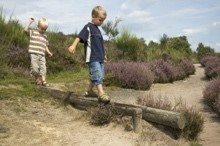In this 3-part series, we will explore how more play, creative expression, and movement can lead to more cognitive development. The link from body to brain is powerful, so getting kids to move more and study a little less throughout the day may seem counterintuitive, but it may actually lead to better grades and even improve behavior!
In part 2 we will explore the mechanisms behind the power of movement to improve the brain. If you missed Part 1, click here.
So how is it possible that more time spent moving and less time spent “learning” results in better grades?
You see, movement is never just a physical act; it is a physical expression, or outcome, of cognitive strategies to solve problems. When learning fundamental or complex movements in the context of physical education, sports, recreation, or free play, it “…is an active learning process intricately interrelated with cognition. Movement skill learning cannot occur without the benefit of higher thought processes” (Gallahue, 2003, p. 104).
Learning is a process that involves the integration of both sensory and motor skills (Gallahue, 2003). Children, therefore, learn best when more of their senses are involved. When kids play, explore and solve problems, especially when outdoors in nature, they are forced to use all their senses to navigate this unpredictable and ever changing environment.

In a review of research on the acquisition of intellectual and perceptual-motor skills, Rosenbaum et al., (2001) concluded that all knowledge is “performatory” and that the ‘skills of mind’ and ‘skills of eye, ear, and muscle’ are fundamentally similar” (p. 454).
A finding Rosenbaum cites to support this fact is that coordination and timing seem to be required for intellectual as well as perceptual-motor skills (p. 464). Rosenbaum also points to the evidence that across animal species, more advanced intellect is associated with a greater facility of motor behaviors such as tool making. This fact has led to the hypothesis that, “…the evolution of brain areas credited with the development of language (e.g. Broca’s area) may have paved the way for complex behavioral sequencing” (p. 465)
Current research points to the fact that exercise directly impacts the ability of the brain to process and retain new information (Ratey & Hagerman, 2008). A common concern in schools today, with the emphasis on learning the academic basics and passing standardized tests, is that physical education classes would take away valuable time from the teacher’s already limited time to prep their students to pass the tests.
 Classroom teachers are understandably concerned as they are also judged by how well their students do on these tests.
Classroom teachers are understandably concerned as they are also judged by how well their students do on these tests.
Any time taken from an already tight schedule is therefore, seen as a threat. In a study reported by Graham et al., (2013) it was found that doubling the amount of physical education time allocated in the course of a school week did not interfere with standardized reading or math scores (p. 680).
Tony Schwartz discussed the basic human needs that must be satisfied in order to maximize performance in all realms of life in his book, The Way We’re Working isn’t Working (2010). He talks about the importance of renewal with the four key factors being, nutrition, fitness, sleep, and rest.
Schwartz asserts that, “Our physical capacity is foundational because every other source of energy depends on it.” (p. 11) He highlights exercise for its importance in increasing work capacity and as a means of calming emotions and quieting the mind, especially in the middle of a workday, and in our case, school day. Schwartz believes therefore, that exercise in the middle of a day, especially after a period of intense work, is a powerful form of rejuvenation.
In part 3 we will discuss how specific forms of exercise affect brain development.
For breakfast, we had the same as last time (I hate to sound boring, but in case you missed it). We have 2 eggs over medium with salt, pepper, and turmeric, sweet potato hash, 1 slice of bacon, sautéed baby kale, chard, and spinach, sautéed cherry tomatoes & fresh avocado – all drizzled with olive oil. Coffee is mandatory, though not for my son, and we all look forward to our spoon of cod liver oil to finish off our breakfast of champions.
Author: @craigvalency
References
Ericsson, I., & Karlsson, M. K. (2012). Motor skills and school performance in children with daily physical education in school – a 9-year intervention study. Scand J Med Sci Sports, 24(2), 273-278. doi:10.1111/j.1600-0838.2012.01458.x
Gallahue, D., & Cleland Donnelly, F. (2003). Developmental Physical education for all children (Fourth ed.). Champaign, Illinois: Human Kinetics.
Graham, G., Holt/Hale, S. A., & Parker, M. (2013). Children moving: A reflective approach to teaching physical education (9th ed.). New York, NY: McGraw-Hill.
Musolf, D. (2014, February 19). Does outdoor play make kids smarter? – San Jose Mercury News. Retrieved from https://www.mercurynews.com/bay-area-living/ci_25181071/does-outdoor-play-make-kids-smarter?source=infinite-up
Ratey, J., & Hagerman, E. (2008). Spark: The Revolutionary New Science of Exercise and the Brain (First ed.). New York, New York: Little, Brown and Company, Hachette Book Group.
Rosenbaum, D. A., Carlson, R. A., & Gilmore, R. O. (2001). Acquisition of intellectual and perceptual-motor skills. Annual Review of Psychology, 52(1), 453-470. doi:10.1146/annurev.psych.52.1.453
Schwartz, T., Gomes, J., & McCarthy, C. (2010). The way we’re working isn’t working: The four forgotten needs that energize great performance. New York, NY: Free Press.
